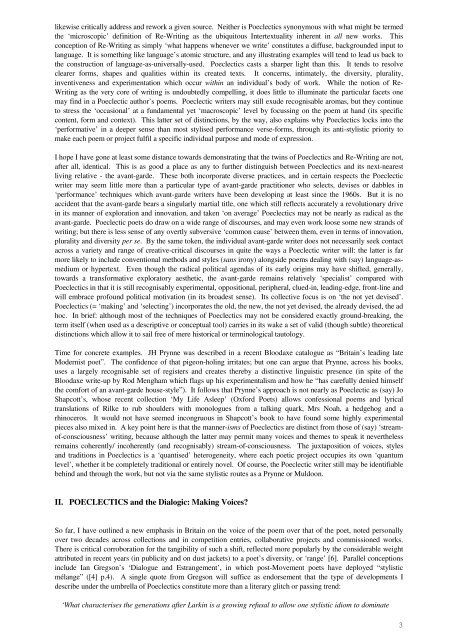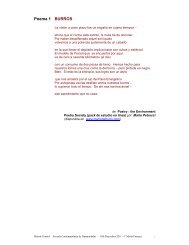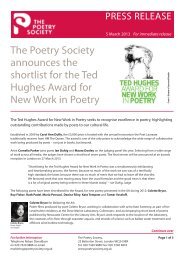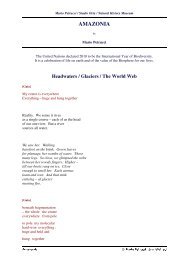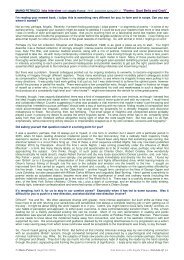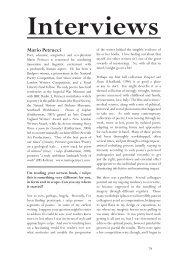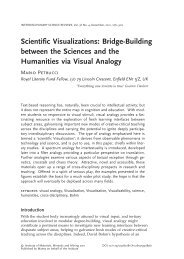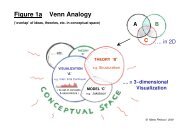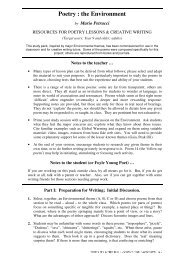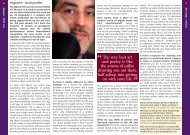poetry in performance: intertextuality, intra-textuality ... - Mario Petrucci
poetry in performance: intertextuality, intra-textuality ... - Mario Petrucci
poetry in performance: intertextuality, intra-textuality ... - Mario Petrucci
You also want an ePaper? Increase the reach of your titles
YUMPU automatically turns print PDFs into web optimized ePapers that Google loves.
likewise critically address and rework a given source. Neither is Poeclectics synonymous with what might be termed<br />
the ‘microscopic’ def<strong>in</strong>ition of Re-Writ<strong>in</strong>g as the ubiquitous Inter<strong>textuality</strong> <strong>in</strong>herent <strong>in</strong> all new works. This<br />
conception of Re-Writ<strong>in</strong>g as simply ‘what happens whenever we write’ constitutes a diffuse, backgrounded <strong>in</strong>put to<br />
language. It is someth<strong>in</strong>g like language’s atomic structure, and any illustrat<strong>in</strong>g examples will tend to lead us back to<br />
the construction of language-as-universally-used. Poeclectics casts a sharper light than this. It tends to resolve<br />
clearer forms, shapes and qualities with<strong>in</strong> its created texts. It concerns, <strong>in</strong>timately, the diversity, plurality,<br />
<strong>in</strong>ventiveness and experimentation which occur with<strong>in</strong> an <strong>in</strong>dividual’s body of work. While the notion of Re-<br />
Writ<strong>in</strong>g as the very core of writ<strong>in</strong>g is undoubtedly compell<strong>in</strong>g, it does little to illum<strong>in</strong>ate the particular facets one<br />
may f<strong>in</strong>d <strong>in</strong> a Poeclectic author’s poems. Poeclectic writers may still exude recognisable aromas, but they cont<strong>in</strong>ue<br />
to stress the ‘occasional’ at a fundamental yet ‘macroscopic’ level by focuss<strong>in</strong>g on the poem at hand (its specific<br />
content, form and context). This latter set of dist<strong>in</strong>ctions, by the way, also expla<strong>in</strong>s why Poeclectics locks <strong>in</strong>to the<br />
‘performative’ <strong>in</strong> a deeper sense than most stylised <strong>performance</strong> verse-forms, through its anti-stylistic priority to<br />
make each poem or project fulfil a specific <strong>in</strong>dividual purpose and mode of expression.<br />
I hope I have gone at least some distance towards demonstrat<strong>in</strong>g that the tw<strong>in</strong>s of Poeclectics and Re-Writ<strong>in</strong>g are not,<br />
after all, identical. This is as good a place as any to further dist<strong>in</strong>guish between Poeclectics and its next-nearest<br />
liv<strong>in</strong>g relative - the avant-garde. These both <strong>in</strong>corporate diverse practices, and <strong>in</strong> certa<strong>in</strong> respects the Poeclectic<br />
writer may seem little more than a particular type of avant-garde practitioner who selects, devises or dabbles <strong>in</strong><br />
‘<strong>performance</strong>’ techniques which avant-garde writers have been develop<strong>in</strong>g at least s<strong>in</strong>ce the 1960s. But it is no<br />
accident that the avant-garde bears a s<strong>in</strong>gularly martial title, one which still reflects accurately a revolutionary drive<br />
<strong>in</strong> its manner of exploration and <strong>in</strong>novation, and taken ‘on average’ Poeclectics may not be nearly as radical as the<br />
avant-garde. Poeclectic poets do draw on a wide range of discourses, and may even work loose some new strands of<br />
writ<strong>in</strong>g; but there is less sense of any overtly subversive ‘common cause’ between them, even <strong>in</strong> terms of <strong>in</strong>novation,<br />
plurality and diversity per se. By the same token, the <strong>in</strong>dividual avant-garde writer does not necessarily seek contact<br />
across a variety and range of creative-critical discourses <strong>in</strong> quite the ways a Poeclectic writer will: the latter is far<br />
more likely to <strong>in</strong>clude conventional methods and styles (sans irony) alongside poems deal<strong>in</strong>g with (say) language-asmedium<br />
or hypertext. Even though the radical political agendas of its early orig<strong>in</strong>s may have shifted, generally,<br />
towards a transformative exploratory aesthetic, the avant-garde rema<strong>in</strong>s relatively ‘specialist’ compared with<br />
Poeclectics <strong>in</strong> that it is still recognisably experimental, oppositional, peripheral, clued-<strong>in</strong>, lead<strong>in</strong>g-edge, front-l<strong>in</strong>e and<br />
will embrace profound political motivation (<strong>in</strong> its broadest sense). Its collective focus is on ‘the not yet devised’.<br />
Poeclectics (= ‘mak<strong>in</strong>g’ and ‘select<strong>in</strong>g’) <strong>in</strong>corporates the old, the new, the not yet devised, the already devised, the ad<br />
hoc. In brief: although most of the techniques of Poeclectics may not be considered exactly ground-break<strong>in</strong>g, the<br />
term itself (when used as a descriptive or conceptual tool) carries <strong>in</strong> its wake a set of valid (though subtle) theoretical<br />
dist<strong>in</strong>ctions which allow it to sail free of mere historical or term<strong>in</strong>ological tautology.<br />
Time for concrete examples. JH Prynne was described <strong>in</strong> a recent Bloodaxe catalogue as “Brita<strong>in</strong>’s lead<strong>in</strong>g late<br />
Modernist poet”. The confidence of that pigeon-hol<strong>in</strong>g irritates; but one can argue that Prynne, across his books,<br />
uses a largely recognisable set of registers and creates thereby a dist<strong>in</strong>ctive l<strong>in</strong>guistic presence (<strong>in</strong> spite of the<br />
Bloodaxe write-up by Rod Mengham which flags up his experimentalism and how he “has carefully denied himself<br />
the comfort of an avant-garde house-style”). It follows that Prynne’s approach is not nearly as Poeclectic as (say) Jo<br />
Shapcott’s, whose recent collection ‘My Life Asleep’ (Oxford Poets) allows confessional poems and lyrical<br />
translations of Rilke to rub shoulders with monologues from a talk<strong>in</strong>g quark, Mrs Noah, a hedgehog and a<br />
rh<strong>in</strong>oceros. It would not have seemed <strong>in</strong>congruous <strong>in</strong> Shapcott’s book to have found some highly experimental<br />
pieces also mixed <strong>in</strong>. A key po<strong>in</strong>t here is that the manner-isms of Poeclectics are dist<strong>in</strong>ct from those of (say) ‘streamof-consciousness’<br />
writ<strong>in</strong>g, because although the latter may permit many voices and themes to speak it nevertheless<br />
rema<strong>in</strong>s coherently/ <strong>in</strong>coherently (and recognisably) stream-of-consciousness. The juxtaposition of voices, styles<br />
and traditions <strong>in</strong> Poeclectics is a ‘quantised’ heterogeneity, where each poetic project occupies its own ‘quantum<br />
level’, whether it be completely traditional or entirely novel. Of course, the Poeclectic writer still may be identifiable<br />
beh<strong>in</strong>d and through the work, but not via the same stylistic routes as a Prynne or Muldoon.<br />
II. POECLECTICS and the Dialogic: Mak<strong>in</strong>g Voices?<br />
So far, I have outl<strong>in</strong>ed a new emphasis <strong>in</strong> Brita<strong>in</strong> on the voice of the poem over that of the poet, noted personally<br />
over two decades across collections and <strong>in</strong> competition entries, collaborative projects and commissioned works.<br />
There is critical corroboration for the tangibility of such a shift, reflected more popularly by the considerable weight<br />
attributed <strong>in</strong> recent years (<strong>in</strong> publicity and on dust jackets) to a poet’s diversity, or ‘range’ [6]. Parallel conceptions<br />
<strong>in</strong>clude Ian Gregson’s ‘Dialogue and Estrangement’, <strong>in</strong> which post-Movement poets have deployed “stylistic<br />
mélange” ([4] p.4). A s<strong>in</strong>gle quote from Gregson will suffice as endorsement that the type of developments I<br />
describe under the umbrella of Poeclectics constitute more than a literary glitch or pass<strong>in</strong>g trend:<br />
‘What characterises the generations after Lark<strong>in</strong> is a grow<strong>in</strong>g refusal to allow one stylistic idiom to dom<strong>in</strong>ate<br />
3


